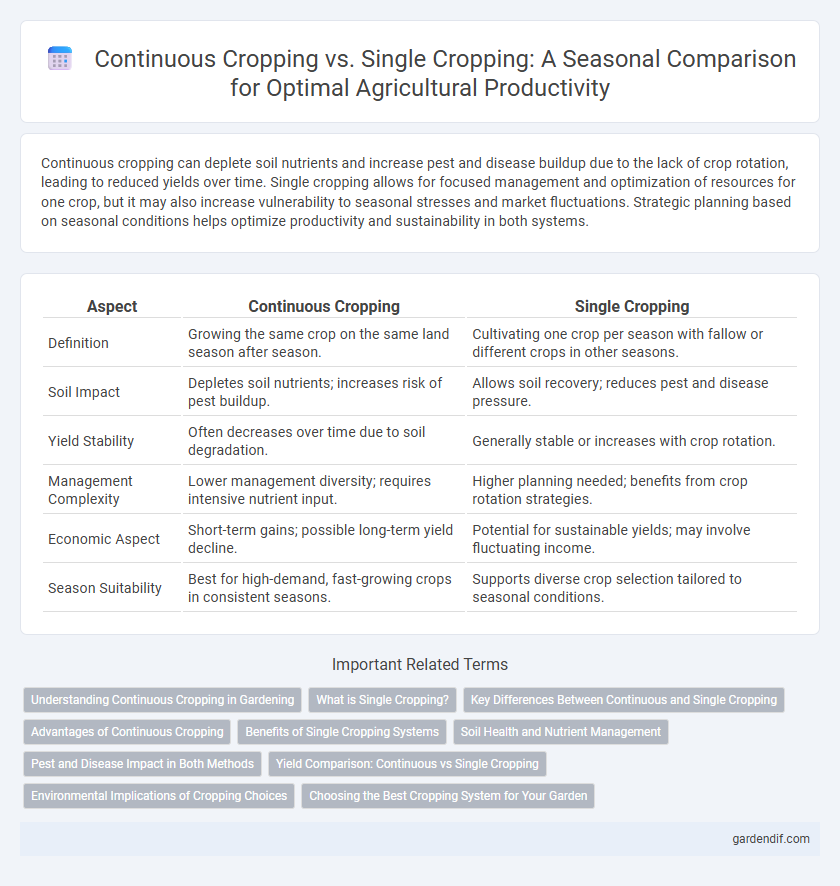
Continuous cropping vs Single cropping Illustration
Continuous cropping can deplete soil nutrients and increase pest and disease buildup due to the lack of crop rotation, leading to reduced yields over time. Single cropping allows for focused management and optimization of resources for one crop, but it may also increase vulnerability to seasonal stresses and market fluctuations. Strategic planning based on seasonal conditions helps optimize productivity and sustainability in both systems.
Table of Comparison
| Aspect | Continuous Cropping | Single Cropping |
|---|---|---|
| Definition | Growing the same crop on the same land season after season. | Cultivating one crop per season with fallow or different crops in other seasons. |
| Soil Impact | Depletes soil nutrients; increases risk of pest buildup. | Allows soil recovery; reduces pest and disease pressure. |
| Yield Stability | Often decreases over time due to soil degradation. | Generally stable or increases with crop rotation. |
| Management Complexity | Lower management diversity; requires intensive nutrient input. | Higher planning needed; benefits from crop rotation strategies. |
| Economic Aspect | Short-term gains; possible long-term yield decline. | Potential for sustainable yields; may involve fluctuating income. |
| Season Suitability | Best for high-demand, fast-growing crops in consistent seasons. | Supports diverse crop selection tailored to seasonal conditions. |
Understanding Continuous Cropping in Gardening
Continuous cropping in gardening involves cultivating the same crop species repeatedly on the same plot throughout multiple seasons, often leading to nutrient depletion and increased susceptibility to pests and diseases. Single cropping, by contrast, grows one crop per season, allowing soil recovery and reducing pathogen buildup. Understanding continuous cropping's impact on soil health is essential for implementing crop rotation or intercropping strategies to maintain long-term garden productivity.
What is Single Cropping?
Single cropping refers to the agricultural practice of growing one type of crop on the same land throughout a single growing season. This method simplifies farm management and reduces operational costs but can increase vulnerability to pests and soil nutrient depletion. Single cropping is commonly used for staple crops like wheat, rice, and maize during their respective main growing seasons.
Key Differences Between Continuous and Single Cropping
Continuous cropping involves planting the same crop on the same land repeatedly across multiple seasons, which can lead to soil nutrient depletion and increased pest pressure. Single cropping, by contrast, refers to growing one crop per season without immediate repetition on the same plot, allowing soil recovery and reducing disease buildup. The key differences lie in soil health impact, pest management, and crop rotation practices influencing long-term sustainability.
Advantages of Continuous Cropping
Continuous cropping maximizes land use efficiency by allowing multiple harvests within a single growing season, leading to increased overall yield. It enhances soil fertility through crop rotation and diverse nutrient uptake, reducing the need for synthetic fertilizers. Continuous cropping supports sustained income for farmers by shortening fallow periods and maintaining consistent production cycles.
Benefits of Single Cropping Systems
Single cropping systems enhance nutrient management by allowing targeted fertilization tailored to one crop, which improves soil health and reduces nutrient depletion. This method simplifies pest and disease control due to crop-specific monitoring, leading to fewer chemical inputs and sustainable crop protection. Farmers benefit from optimized labor and machinery use, resulting in increased efficiency and potentially higher yields per season.
Soil Health and Nutrient Management
Continuous cropping often leads to nutrient depletion and reduced soil organic matter, increasing the risk of soil erosion and degradation. Single cropping allows for targeted nutrient management and crop rotation, which helps maintain soil fertility and microbial diversity. Effective soil health monitoring and balanced fertilization strategies are essential to sustain productivity in both cropping systems.
Pest and Disease Impact in Both Methods
Continuous cropping often leads to increased pest and disease pressure due to the constant presence of the same host plants, which allows pathogens and pests to establish and multiply more easily. Single cropping, with its rotational breaks, disrupts pest and disease life cycles, reducing infestations and outbreaks. Crop diversity and proper management in single cropping systems enhance natural pest resistance and minimize the buildup of harmful organisms.
Yield Comparison: Continuous vs Single Cropping
Continuous cropping often leads to decreased yield over multiple seasons due to soil nutrient depletion and increased pest pressure, whereas single cropping typically maintains higher productivity by allowing soil recovery periods. Studies indicate that single cropping systems can achieve yield increases of up to 20-30% compared to continuous cropping under similar environmental conditions. Optimizing crop rotation and incorporating cover crops further mitigates yield decline observed in continuous cropping practices.
Environmental Implications of Cropping Choices
Continuous cropping depletes soil nutrients rapidly, increasing the need for synthetic fertilizers that contribute to water pollution and greenhouse gas emissions. Single cropping, while reducing nutrient depletion, can lead to reduced biodiversity and increased vulnerability to pests, often necessitating higher pesticide use. Crop rotation or integrated cropping systems offer a sustainable alternative by enhancing soil health, reducing chemical inputs, and supporting ecosystem balance.
Choosing the Best Cropping System for Your Garden
Continuous cropping maximizes land use by planting multiple crops in succession during a single season, enhancing soil nutrient cycling and increasing overall yield. Single cropping, with one crop cultivated per season, simplifies management and reduces pest and disease risks. Selecting the best system depends on your garden's soil health, climate, crop type, and labor availability to balance productivity and sustainability.
Continuous cropping vs Single cropping Infographic

 gardendif.com
gardendif.com